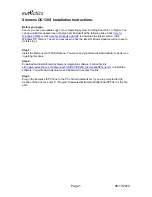
belong to both sets, the default, or only to the working rule set. After you
add a rule to a rule set, you can no longer change the rule. Instead, you copy
the rule and replace items or patterns in the copy. By default, Auto Deploy
uses the name of the rule for the copy and hides the original rule.
Active Rule Set
When a newly started host contacts the Auto Deploy server with a request
for an image profile, the Auto Deploy server checks the active rule set for
matching rules. The image profile, host profile, and vCenter Server inventory
location that are mapped by matching rules are then used to boot the host. If
more than one item of the same type is mapped by the rules, the Auto
Deploy server uses the item that is first in the rule set.
Working Rule Set
The working rule set allows you to test changes to rules before making the
changes active. For example, you can use Auto Deploy PowerCLI cmdlets for
testing compliance with the working rule set. The test verifies that hosts
managed by a vCenter Server system are following the rules in the working
rule set. By default, cmdlets add the rule to the working rule set and activate
the rules. Use the
NoActivate
parameter to add a rule only to the working
rule set.
You use the following workflow with rules and rule sets.
1
Make changes to the working rule set.
2
Use cmdlets that execute the working rule set rules against a host to make sure that everything is
working correctly.
3
Refine and retest the rules in the working rule set.
4
Activate the rules in the working rule set.
If you add a rule and do not specify the
NoActivate
parameter, all rules that are currently in the
working rule set are activated. You cannot activate individual rules.
See the PowerCLI command-line help and
“Managing Auto Deploy with PowerCLI Cmdlets,”
on page 173.
Auto Deploy Boot Process
When you boot a host that you want to provision or reprovision with vSphere Auto Deploy, the Auto
Deploy infrastructure supplies the image profile and, optionally, a host profile and a vCenter Server location
for that host.
The boot process is different for hosts that have not yet been provisioned with Auto Deploy (first boot) and
for hosts that have been provisioned with Auto Deploy and added to a vCenter Server system (subsequent
boot).
First Boot Prerequisites
Before a first boot process, you must set up your system. Setup includes the following tasks, which are
discussed in more detail in
“Preparing for vSphere Auto Deploy,”
on page 167.
n
Set up a DHCP server that assigns an IP address to each host upon startup and that points the host to
the TFTP server to download the iPXE boot loader from.
n
Ensure that the Auto Deploy server has an IPv4 address. PXE booting is supported only with IPv4.
Other components in your Auto Deploy infrastructure can communicate either with IPv4 or with IPv6.
n
Identify an image profile to be used in one of the following ways.
n
Choose an ESXi image profile in a public depot.
n
(Optional) Create a custom image profile by using the Image Builder PowerCLI, and place the
image profile in a depot that the Auto Deploy server can access. The image profile must include a
base ESXi VIB.
vSphere Installation and Setup
160
VMware, Inc.
Содержание VS4-ENT-PL-A - vSphere Enterprise Plus
Страница 6: ...vSphere Installation and Setup 6 VMware Inc ...
Страница 8: ...vSphere Installation and Setup 8 VMware Inc ...
Страница 10: ...vSphere Installation and Setup 10 VMware Inc ...
Страница 28: ...vSphere Installation and Setup 28 VMware Inc ...
Страница 70: ...vSphere Installation and Setup 70 VMware Inc ...
Страница 100: ...vSphere Installation and Setup 100 VMware Inc ...
Страница 122: ...vSphere Installation and Setup 122 VMware Inc ...
Страница 138: ...vSphere Installation and Setup 138 VMware Inc ...
















































